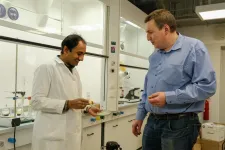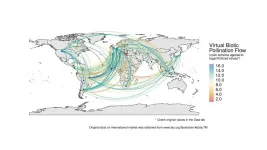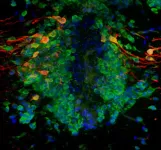INFORMATION:
Words conveyed with gesture
2021-03-23
(Press-News.org) The question of the origin of the language is one of the most important and at the same time one of the most difficult to solve. It was formulated in antiquity and has inspired religion and philosophy ever since, in some periods, above all the Enlightenment, becoming the axis of reflection on other fundamental issues, such as human nature. In the last few decades, research in this field has intensified, drawing on evolutionism and having an interdisciplinary character, involving linguists, psychologists, primatologists and neuroscientists. The study of language evolution is currently considered one of the most intensively developing fields of communication research, and publications in this field appear in the most important scientific journals in the world. - I once made a review of various world creation myths and in all of them there is a smaller or larger element of reflection on the origin of language and diversification of languages, says Prof. Przemys?aw ?ywiczy?ski from the Institute of Linguistics at the Faculty of Humanities at the Nicolaus Copernicus University in Toru?. - In the Western, Judeo-Christian tradition, we have the biblical story of how Adam named the animals, creating - the first - Adamic language, then the myth of the tower of Babel. This indirectly shows that the problem of the origin of language has always been important to us, because it says something important about our humanity.
The modern study of the evolution of language is a scientific emanation of the need to answer the question of where the language came from.
Language is a system of communication specific to humans. - While in relation to other species we can talk about complex communication, for instance, monkeys have a number of the so-called calls and extensive gesture communication, we cannot talk about the language in their case - explains Prof. ?ywiczy?ski. - If we are to define a language, we must remember that it is based on meaning. There is a vocal form in the case of spoken languages, or a gesture, or a sign, in the case of sign languages, and something distinct which that form means. This kind of relationship between the form and the content is basically absent in the world of animals.
The second thing that distinguishes language is its compositionality, which means that units of meaning can be combined and new meanings can be constructed. For instance, if we have the words: "red" and " car", we don't always have to use them separately, but we can combine them, and then, there is a new content, i.e., a car that is red. This kind of ability doesn't actually occur in the animal world either.
What we recognise to be the beginning of language depends on how narrow a definition of language we want to use. If we refer to the origins of the relationship between the form and the meaning, most researchers, considering the size of the brain, the technological advances or the size of the groups, would say that around 2 million years ago there was a breakthrough in human evolution, when a new system of communication must have emerged. However, when it comes to language in the strict sense, some researchers date its origins to more than half a million years ago, when we had a common ancestor with the Neanderthal. Research into the genes responsible for language vocalisations, which our relative species also had, provides support here. This is the upper limit of the origin of language, while the lower limit is connected by most researchers with the origin of the human species, which occurred about 200 thousand years ago.
The researcher from Toru? points out that although animals do not have a language, they can obviously communicate. - The basic definition of communication comes from Krebs and Dawkins who believed that the primary function of communication was manipulation, explains Prof. ?ywiczy?ski. - Generally speaking, it is such a behaviour of an organism A that causes changes in the behaviour of an organism B. This is how, for example, sexual selection works or the interaction between the hunter and the prey he hunts. However, in the case of humans, we also have meanings and communication is about making these meanings consistent. So that the sender of the message is able to make what is in his mind consistent with what is in the mind of the receiver of the message.
If you put people in experimental conditions and forbid them to use language, you can observe what means they will use to start communicating. Research unanimously shows that iconic strategies work best here. - If I say the word "key", there is nothing in this form itself that suggests what I am talking about, whereas if I draw a "key", we are dealing with iconicity - explains the researcher from the Nicolaus Copernicus University. - Drawing through similarity reflects the things we want to draw our attention to. If we talk about communication in interaction, when you can't always draw, gestures - or more broadly, what we call pantomime - is definitely a better strategy to start communicating than, for example, vocal communication, which is based on more arbitrary forms than gestural communication. It is easier to draw something with your hands than to do it with your voice.
The study of the origins of language and communication as a research project became possible when empirical data allowed us to go beyond speculation. Developments in ape communication research, neuroscience, psycholinguistics or genetics were all elements that, taken together, made it possible to talk about how language might have evolved. - In the contemporary evolution of language, we mainly study detailed problems, e.g., which modality is best suited to establish communication, explains the linguist from Toru?. - We solve a research problem, which sometimes helps us to say something more general about the origin of language. This is how the various 'puzzles' are put together, but they will never form a perfect whole, because the study of the origin of language and language itself is a multi-layered process. We have talked about the brain, communication, but language also relates to social expression. What we say and how we say it, is determined by our social relations, the group we live in, its size and even the natural conditions we live in. We have a very large catalogued description of languages, in fact almost all languages in existence today, which is about 7,000. The distribution of language features can be correlated with the features of the environment in which their speakers live. For example, tonal languages are more popular in humid climates than in dry ones, because humid air promotes better vocal cords. All this shows that the picture is quite complex. By looking at one thing, we don't see another, but we still know a little more at the end.
The latest issue of the scientific journal Philosophical Transactions of the Royal Society B entitled "Reconstructing prehistoric languages" is devoted to the topic of the origins of language. Among the papers published in the journal there is an article "Pantomimic fossils in modern human communication" by Prof. ?ywiczy?ski and dr. hab. S?awomir Wacewicz, NCU Prof. from the Centre for Language Evolution Studies, written in collaboration with dr Casey Lister from the University of Western Australia.
The authors present a number of arguments for the pantomimic origin of language. We usually associate pantomime with a theatrical genre or a game of puns. However, in the study of language evolution, the view that pantomime was an important link in the evolutionary development of language is gaining popularity. A well-known and popular view says that it is likely that pantomime played an important role in the early stages of language formation, but in fact it is with us all the time, and what we have focused on are the contexts of how pantomime appears in the communication of people today, explains Prof. ?ywiczy?ski. - It usually occurs when people cannot use a language, because they have been experimentally forbidden to do so, or they don't have a common language, or they are unable to use it.
The researchers studied records from the period of the great discoveries, when the sailors did not know what awaited them in the new land, and yet somehow managed to communicate with indigenous people. The observations on newly emerging sign languages are also interesting, because there you can see how a language is born from the moment when people have no system for communicating with each other, to a fully formed system. Since the 1990s, there have been several cases where researchers have managed to study such a language from its very formation. The best-known case is Nicaraguan sign language. In Nicaragua, there was no language for deaf children to learn and no schools for them. The Americans came and set up a school to teach them American sign language. It turned out that before they did so, the little ones had created their own language. Studies on emerging languages show that at the beginning communication is based on pantomime, on whole-body expression, only later do the proper signs for a given language take shape and the grammar of the sign language develops.
The use of pantomime is also linked to language deficits - for example, in the case of aphasia, when language expression becomes limited due to brain damage, but gestures or pantomime are largely unaffected. This shows that on a cerebral level, pantomime, gestures and vocal language are - at least partly - separate, and people who cannot speak start using pantomime spontaneously, and very often this becomes the basis for language therapy.
Another important feature of human communication highlighted by the researchers of language evolution is multimodality. When we speak, we also gesture, and we often use, for example, graphic signs in our communication. Very often, traditional narratives creatively combine voice, pantomime and drawing.
The researchers assume that the primary communication system was an iconic one, with pantomime at its core, which made it much easier to convey meaning. However, elements such as drawing and vocalisation complemented it. The development of language was based on increasing the role of vocalisation at the expense of pantomime. Why is it that today, we mainly talk and not show? When we start communicating, the iconic form is great, because it's easy to explain something by showing or drawing, but when we have more and more meanings, iconicity becomes an obstacle. - For example, it' s difficult to clearly separate kicking the ball from the footballer when using pantomime alone, explains the linguist from the Nicolaus Copernicus University. - If we have a general notion of kicking the ball, it's easy to show it, but if we want to show 'footballer' and 'kick the ball' separately, it's not so easy. When we have to convey a growing number of increasingly subtle meanings, the iconicity of the pantomime becomes a limitation for the development of communication, and then we need something more arbitrary, and that is the spoken word.
ELSE PRESS RELEASES FROM THIS DATE:
Pandemic exacerbates challenges for international energy transition
2021-03-23
The Covid-19 Crisis is deepening the divide between energy transition frontrunners and laggards. In a new publication, researchers from the Institute for Advanced Sustainability Studies (IASS) in Potsdam present an overview of the global impact of the coronavirus pandemic on the energy sector. Their findings show that low- and middle-income countries need more support in their efforts to ditch fossil fuels.
The crisis will heighten existing imbalances in an uneven energy transition landscape. Despite the crisis, frontrunners in the global energy transition will continue to expand their renewable energy capacities, while laggards will fall further behind. In Europe, the Green Deal ...
Preemies at greater risk for mortality in adulthood
2021-03-23
A new study of mortality among young adults born prematurely includes 6.3 million adults under the age of 50 in Norway, Sweden, Finland and Denmark. Among this group, 5.4 per cent were born before term, according to Professor Kari Risnes at the Norwegian University of Science and Technology's (NTNU) Department of Clinical and Molecular Medicine and St. Olavs Hospital.
Researchers used national birth registers and compared them with the cause of death registers that all Scandinavian countries have.
"We already know that preemies have increased mortality in childhood and early adulthood. Now we've confirmed the risk of death from chronic diseases such as heart disease, ...
New evidence in search for the mysterious Denisovans
2021-03-23
An international group of researchers led by the University of Adelaide has conducted a comprehensive genetic analysis and found no evidence of interbreeding between modern humans and the ancient humans known from fossil records in Island Southeast Asia. They did find further DNA evidence of our mysterious ancient cousins, the Denisovans, which could mean there are major discoveries to come in the region.
In the study published in Nature Ecology and Evolution, the researchers examined the genomes of more than 400 modern humans to investigate the interbreeding events between ancient humans and modern ...
Key research advance could spawn new treatments for heart diseases
2021-03-23
TALLAHASSEE, Fla. -- Scientists peering into the beating heart have solved a decades-old, fundamental mystery about how the heart works. The revelation could herald the development of new treatments for heart diseases -- the leading cause of death worldwide.
Researchers from Eastern Virginia Medical School, Florida State University and the University of Virginia have observed a tiny muscle filament during a crucial stage in a beating heart for the first time. The research was published in Proceedings of the National Academy of Sciences.
The heart is a unique muscle which contracts and relaxes about once every second ...
Deaths from COVID-19 have progressively declined at nursing homes, researchers find
2021-03-23
PROVIDENCE, R.I. [Brown University] -- The COVID-19 pandemic has had devastating effects in U.S. nursing homes and long-term care facilities, resulting in an estimated 1.2 million infections and 147,000 deaths as of early 2021. Yet even as mortality rates in the general population have decreased over time, little evidence has been uncovered to determine whether nursing home residences have experienced similar reductions.
Now, new data collected and analyzed by researchers at Brown University shows that mortality rates among nursing home residents with COVID-19 declined from March to November 2020, and that the deadliest ...
Scientists created edible food films for food packaging
2021-03-23
An international group of scientists from India and Russia has created edible food films for packaging fruits, vegetables, poultry, meat, and seafood. Films consist of natural ingredients, they are safe for health and the environment. In addition, films are water-soluble and dissolve by almost 90% in 24 hours. Description of the research and results of experiments are published in the Journal of Food Engineering.
"We have created three types of food films based on the well-known naturally occurring seaweed biopolymer sodium alginate," said Rammohan Aluru, senior researcher Organic synthesis laboratory at Ural Federal University and co-author of the paper. "Its molecules have film-forming ...
Virtual pollination trade uncovers global dependence on biodiversity for food consumption
2021-03-23
Recently, a published study in Science Advances assessed the contribution of pollinators to international market flows and showed that biodiversity conservation is essential to sustain global consumption patterns. This study results from the work of an interdisciplinary team that integrated researchers across the fields of economics, ecology, environmental sciences and social sciences.
Given the growing global demand for crops, sustainability in agriculture is one of the main challenges for human society. Together with the excessive use of chemical inputs, the loss of natural habitat associated with cropland expansion is one of the main drivers ...
CHOP researchers find supplement prevents strokes in patients with rare genetic disorder
2021-03-23
Philadelphia, March 23, 2021 - Researchers from Children's Hospital of Philadelphia (CHOP) have discovered that a widely used nutritional supplement may significantly reduce the risk of fatal strokes caused by a rare genetic disorder. Additionally, the findings suggest that the supplement could be used to both block precipitation of and break up the formation of amyloid plaque deposits, a common feature found in serious forms of dementia. The findings were published online today by the journal Nature Communications.
The findings centered around a genetic disorder known as hereditary cystatin C amyloid angiopathy (HCCAA). HCCAA is part ...
Algorithms inspired by social networks reveal lifecycle of substorms, a key element of space weather
2021-03-23
Evolution of auroral substorms revealed by physicists at University of Warwick using the same methods that link people through social media
'If you like this magnetometer, you might like this one too:' historical data from magnetometers used to match them with 'like-minded friends' during 41 substorms
Shows that a single coherent electrical current, that accompanies the Northern Lights during substorms, covers most of the Earth's night-side at high latitudes
Will help to validate models used to predict auroral substorms, which can disrupt electronics and power distribution systems
Space weather often manifests as substorms, where a beautiful auroral display such as the Northern Lights is accompanied ...
Parkinson's gene may impair how new neurons are made throughout our lifetime
2021-03-23
A pioneering study, published in Scientific Reports, found that the Parkinon's gene PINK1 is important for the generation of dopamine-producing neurons throughout life, and is not just responsible for the premature death of these neurons
The international research, led by University of Sheffield's Neuroscience Institute, used two model systems to examine how neurons are produced throughout our lifetime
Parkinson's disease is a relentlessly progressive neurodegenerative disorder that affects around 145,000 people in the UK
A gene defect linked to Parkinson's disease may not only cause the early death of neurons, ...





